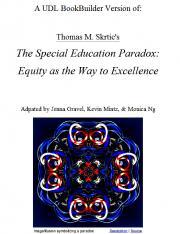 The PITF team built on Skrtic’s article to transform it into a supported, digital reading environment that benefits the diversity of students in the course. Using BookBuilder, a free tool created by the Center for Applied Special Technology (CAST), PITFs embedded the following features into the reading environment:
The PITF team built on Skrtic’s article to transform it into a supported, digital reading environment that benefits the diversity of students in the course. Using BookBuilder, a free tool created by the Center for Applied Special Technology (CAST), PITFs embedded the following features into the reading environment:
a) A “TextHelp Toolbar” that offered students text-to-speech, highlighting features, and translation tools
b) A multimedia glossary of key terms Links to resources that activated or supplied background knowledge
c) Prompts for comprehension and reflection.
The resource was available on the course iSite to all students in the class. The resource served two purposes: first, it modeled pedagogical concepts about implementing inclusive education and showed that this work could be done using tools that were freely available and easy to use. Secondly, it assisted students in better understanding the concepts in the article itself.
... Read more about Using Universal Design for Learning Principles to Create an Intellectually Accessible Version of a Challenging Scholarly Article